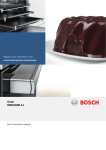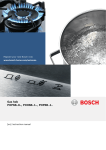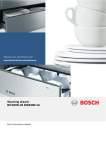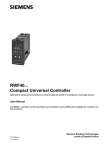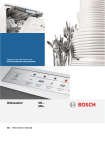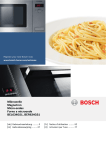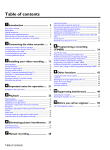Download User`s Manual
Transcript
Microwave BEL634GS1B, BER634GS1B [en] Instruction manual en Table of contents no i t c u r t s n I ] ne [ 8 Intended use . . . . . . . . . . . . . . . . . . . . . . . . . . . . . 4 ( Important safety information . . . . . . . . . . . . . . . 4 3 Trouble shooting . . . . . . . . . . . . . . . . . . . . . . . . 19 4 Customer service . . . . . . . . . . . . . . . . . . . . . . . . 20 General information . . . . . . . . . . . . . . . . . . . . . . . . . . . 4 Microwave . . . . . . . . . . . . . . . . . . . . . . . . . . . . . . . . . . 5 E number and FD number . . . . . . . . . . . . . . . . . . . . .20 Technical specifications . . . . . . . . . . . . . . . . . . . . . . .20 ] Causes of damage . . . . . . . . . . . . . . . . . . . . . . . . 6 7 Environmental protection . . . . . . . . . . . . . . . . . . 6 J Tested for you in our cooking studio . . . . . . . . 21 Environmentally-friendly disposal . . . . . . . . . . . . . . . . . 6 * Getting to know your appliance . . . . . . . . . . . . . 7 Control panel . . . . . . . Controls . . . . . . . . . . . Display . . . . . . . . . . . . Further information . . . Cooking compartment ........ ........ ........ ........ functions . . . . . . . . . . . . . . . . . . . . . . . . . . . . . . . . . . . . . . . . . . . . . . . . . . . . . . . . . . . . . . . . . . . . . . . . . . . . . . . . .7 .7 .8 .8 .8 _ Accessories . . . . . . . . . . . . . . . . . . . . . . . . . . . . . 9 K Before using for the first time . . . . . . . . . . . . . . . 9 Defrosting . . . . . . . . . . . . . . . . . . . . . . . . Defrosting, heating up or cooking frozen Heating . . . . . . . . . . . . . . . . . . . . . . . . . . Cooking . . . . . . . . . . . . . . . . . . . . . . . . . Microwave tips . . . . . . . . . . . . . . . . . . . . Grilling . . . . . . . . . . . . . . . . . . . . . . . . . . Combined grill and microwave . . . . . . . . ..... food . ..... ..... ..... ..... ..... . . . . . . . . . . . . . . . . . . . . . . . . . . . . .21 .22 .23 .24 .24 .25 .25 E Test dishes . . . . . . . . . . . . . . . . . . . . . . . . . . . . . 26 Cooking only using the microwave. . . . . . . . . . . . . . .26 Defrosting only using the microwave . . . . . . . . . . . . .26 Cooking with the microwave and grill . . . . . . . . . . . . .26 Initial use . . . . . . . . . . . . . . . . . . . . . . . . . . . . . . . . . . . 9 Cleaning the cooking compartment and accessories . 9 Produktinfo 1 Operating the appliance . . . . . . . . . . . . . . . . . . 10 Switching the appliance on and off . . . . . . . . . . . . . . 10 Operation . . . . . . . . . . . . . . . . . . . . . . . . . . . . . . . . . . 10 Selecting an operating mode . . . . . . . . . . . . . . . . . . . 10 Additional information on products, accessories, replacement parts and services can be found at www.bosch-home.com and in the online shop www.bosch-eshop.com ^ Microwave . . . . . . . . . . . . . . . . . . . . . . . . . . . . . . 11 Cookware. . . . . . . . . . . . . . . . . . . . . . . . . . . . . . . . . . 11 Microwave output settings . . . . . . . . . . . . . . . . . . . . . 11 Setting the microwave . . . . . . . . . . . . . . . . . . . . . . . . 11 d Grilling. . . . . . . . . . . . . . . . . . . . . . . . . . . . . . . . . 12 Setting the grill . . . . . . . . . . . . . . . . . . . . . . . . . . . . . . 12 Setting the microwave to combi-mode . . . . . . . . . . . . 13 O Timer . . . . . . . . . . . . . . . . . . . . . . . . . . . . . . . . . . 14 P Programmes . . . . . . . . . . . . . . . . . . . . . . . . . . . . 14 Setting a programme . . . . . . . . . Information on the programmes. Resting time . . . . . . . . . . . . . . . . Programme table . . . . . . . . . . . . . . . . . . . . . . . . . . . . . . . . . . . . . . . . . . . . . . . . . . . . . . . . . . . . . . . . . . . . . . . . . 14 . 15 . 15 . 16 Q Basic settings. . . . . . . . . . . . . . . . . . . . . . . . . . . 17 Changing the basic settings. List of basic settings . . . . . . Power cut . . . . . . . . . . . . . . . Changing the time . . . . . . . . . . . . . . . . . . . . . . . . . . . . . . . . . . . . . . . . . . . . . . . . . . . . . . . . . . . . . . . . . . . . . . . . . . . . . . . . . 17 . 17 . 17 . 17 D Cleaning . . . . . . . . . . . . . . . . . . . . . . . . . . . . . . . 18 Cleaning agent. . . . . . . . . . . . . . . . . . . . . . . . . . . . . . 18 3 l aunam en Intended use 8Intended use Read these instructions carefully. Only then will you be able to operate your appliance safely and correctly. Retain the instruction manual and installation instructions for future use or for subsequent owners. This appliance is only intended to be fully fitted in a kitchen. Observe the special installation instructions. Check the appliance for damage after unpacking it. Do not connect the appliance if it has been damaged in transport. Only a licensed professional may connect appliances without plugs. Damage caused by incorrect connection is not covered under warranty. This appliance is intended for domestic use only. The appliance must only be used for the preparation of food and drink. The appliance must be supervised during operation. Only use this appliance indoors. This appliance may be used by children over the age of 8 years old and by persons with reduced physical, sensory or mental capabilities or by persons with a lack of experience or knowledge if they are supervised or are instructed by a person responsible for their safety how to use the appliance safely and have understood the associated hazards. Children must not play with, on, or around the appliance. Children must not clean the appliance or carry out general maintenance unless they are at least 8 years old and are being supervised. Keep children below the age of 8 years old at a safe distance from the appliance and power cable. Always slide accessories into the cooking compartment the right way round. ~ "Accessories" on page 9 e s u dedne t n I (Important safety information General information no i t amro f n i y t e f as t na t ropmI : Warning Risk of fire! Combustible items stored in the cooking compartment may catch fire. Never store combustible items in the cooking compartment. Never open the appliance door if there is smoke inside. Switch off the appliance and unplug it from the mains or switch off the circuit breaker in the fuse box. : Warning Risk of burns! ■ The appliance becomes very hot. Never touch the interior surfaces of the cooking compartment or the heating elements. Always allow the appliance to cool down. Keep children at a safe distance. Risk of serious burns! ■ Accessories and ovenware become very hot. Always use oven gloves to remove accessories or ovenware from the cooking compartment. Risk of burns!vapours may catch fire in the hot ■ Alcoholic cooking compartment. Never prepare food containing large quantities of drinks with a high alcohol content. Only use small quantities of drinks with a high alcohol content. Open the appliance door with care. : Warning Risk of scalding! ■ The accessible parts become hot during operation. Never touch the hot parts. Keep children at a safe distance. Risk of scalding! ■ When you open the appliance door, hot steam may escape. Open the appliance door with care. Keep children at a safe distance. Risk of scalding! ■ Water in a hot cooking compartment may create hot steam. Never pour water into the hot cooking compartment. : Warning Risk of injury! ■ Scratched glass in the appliance door may develop into a crack. Do not use a glass scraper, sharp or abrasive cleaning aids or detergents. Risk of injury! ■ The hinges on the appliance door move when opening and closing the door, and you may be trapped. Keep your hands away from the hinges. 4 Important safety information : Warning Risk of electric shock! ■ Incorrect repairs are dangerous. Repairs may only be carried out and damaged power cables replaced by one of our trained after-sales technicians. If the appliance is defective, unplug the appliance from the mains or switch off the circuit breaker in the fuse box. Contact the aftersales service. Risk of electric shock and serious injury! ■ The cable insulation on electrical appliances may melt when touching hot parts of the appliance. Never bring electrical appliance cables into contact with hot parts of the appliance. Risk electric ■ Doofnot use shock! any high-pressure cleaners or steam cleaners, which can result in an electric shock. Risk electric shock! ■ A of defective appliance may cause electric shock. Never switch on a defective appliance. Unplug the appliance from the mains or switch off the circuit breaker in the fuse box. Contact the after-sales service. : Warning Hazard due to magnetism! Permanent magnets are used in the control panel or in the control elements. They may affect electronic implants, e.g. heart pacemakers or insulin pumps. Wearers of electronic implants must stay at least 10 cm away from the control panel. Microwave : Warning Risk of fire! Using the appliance for anything other than its intended purpose is dangerous and may cause damage. The following is not permitted: drying out food or clothing, heating slippers, grain or cereal pillows, sponges, damp cleaning cloths or similar. For example, heated slippers and grain or cereal pillows may catch fire, even several hours after they have been heated.The appliance must only be used for the preparation of food and drinks. Risk of fire! ■ en Food may catch fire. Never heat food in heat-retaining packages. Do not leave food heating unattended in containers made of plastic, paper or other combustible materials. Do not select a microwave power or time setting that is higher than necessary. Follow the information provided in this instruction manual. Never use the microwave to dry food. Never defrost or heat food with a low water content, e.g. bread, at too high a microwave power or for too long. Risk of fire! oil may catch fire. Never use the ■ Cooking microwave to heat cooking oil on its own. ■ : Warning Risk of explosion! Liquids and other food may explode when in containers that have been tightly sealed. Never heat liquids or other food in containers that have been tightly sealed. : Warning Risk of burns! ■ Foods with peel or skin may burst or explode during, or even after, heating. Never cook eggs in their shells or reheat hard-boiled eggs. Never cook shellfish or crustaceans. Always prick the yolk when baking or poaching eggs. The skin of foods that have a peel or skin, such as apples, tomatoes, potatoes and sausages, may burst. Before heating, prick the peel or skin. Risk of burns! ■ Heat is not distributed evenly through baby food. Never heat baby food in closed containers. Always remove the lid or teat. Stir or shake well after the food has been heated. Check the temperature of the food before it is given to the child. Risk of burns! ■ Heated food gives off heat. The ovenware may become hot. Always use oven gloves to remove ovenware or accessories from the cooking compartment. Risk of burns! ■ Airtight packaging may burst when food is heated. Always observe the instructions on the packaging. Always use oven gloves to remove dishes from the cooking compartment. 5 en Causes of damage : Warning Risk of scalding! There is a possibility of delayed boiling when a liquid is heated. This means that the liquid reaches boiling temperature without the usual steam bubbles rising to the surface. Even if the container only vibrates a little, the hot liquid may suddenly boil over and spatter. When heating, always place a spoon in the container. This will prevent delayed boiling. : Warning Risk of injury! Unsuitable ovenware may crack. Porcelain or ceramic ovenware can have small perforations in the handles or lids. These perforations conceal a cavity below. Any moisture that penetrates this cavity could cause the ovenware to crack. Only use microwave-safe ovenware. : Warning Risk of electric shock! The appliance is a high-voltage appliance. Never remove the casing. : Warning Risk of serious damage to health! ■ The surface of the appliance may become damaged if it is not cleaned properly. Microwave energy may escape. Clean the appliance on a regular basis, and remove any food residue immediately. Always keep the cooking compartment, door seal, door and door stop clean. ~ "Cleaning" on page 18 Risk of serious damage health! ■ Microwave energy to may escape if the cooking compartment door or the door seal is damaged. Never use the appliance if the cooking compartment door or the door seal is damaged. Contact the after-sales service. Risk of serious damage health! ■ Microwave energy to will escape from appliances that do not have any casing. Never remove the casing. For any maintenance or repair work, contact the after-sales service. ]Causes of damage Caution! ■ Creation of sparks: Metal – e.g. a spoon in a glass – must be kept at least 2 cm from the cooking compartment walls and the inside of the door. Sparks can irreparably damage the glass on the inside of the door. ■ Foil containers: Do not use foil containers in the appliance. They damage the appliance by producing sparks. ■ Operating the microwave without food: Operating the appliance without food in the cooking compartment may lead to overloading. Never switch on the microwave unless there is food inside. The short crockery test is the exception to this rule. ~ "Operating the appliance" on page 10 ■ Moisture in the cooking compartment: Over an extended period of time, moisture in the cooking compartment may lead to corrosion. Allow the cooking compartment to dry after use. Do not keep moist food in the closed cooking compartment for extended periods of time. Do not store food in the cooking compartment. ■ Cooling with the appliance door open: Following operation at high temperatures, only allow the cooking compartment to cool down with the door closed. Do not trap anything in the appliance door. Even if the door is only left open a crack, the front of nearby furniture may become damaged over time. Only leave the cooking compartment to dry with the door open if a lot of moisture was produced whilst the oven was operating. ■ Extremely dirty seal: If the seal is very dirty, the appliance door will no longer close properly during operation. The fronts of adjacent units could be damaged. Always keep the seal clean. ~ "Cleaning" on page 18 ■ Microwave popcorn: Never set the microwave output too high. Use a maximum microwave output of 600 watts. Always place the popcorn bag on a glass plate. The door panels may jump if overloaded. egam d f o sesuaC 7Environmental protection Environmentally-friendly disposal no i t ce t orp l a t nemnor i vnE Dispose of packaging in an environmentally-friendly manner. This appliance is labelled in accordance with European Directive 2012/19/EU concerning used electrical and electronic appliances (waste electrical and electronic equipment WEEE). The guideline determines the framework for the return and recycling of used appliances as applicable throughout the EU. 6 Getting to know your appliance Control panel *Getting to know your appliance In the control panel, you can use the various buttons, touch fields and the rotary selector to set the required function of the appliance. The current settings are shown in the display. The overview shows the control panel when the appliance is switched on with a selected operating mode. In this chapter, we will explain the displays and controls. You will also find out about the various functions of your appliance. ecna i l p a ruoy wonk o t gn i t eG Note: Depending on the appliance model, individual details and colours may differ. RQ en VWDUW : +HL]DUWHQ [PV VWRS RII ( Buttons The buttons on the left- and right-hand side of the control panel have a pressure point. Press these buttons to activate them. For appliances that do not have a stainless steel front, these two button touch fields do not have a pressure point. 0 Touch fields There are sensors under the touch fields. Simply touch the respective symbol to select the function. 8 Rotary selector The rotary selector is fitted so that you can turn it indefinitely to the left or right. Press it lightly and move it in the direction required using your finger. @ Display You can see the current adjustment values, options or notes in the display. Controls The individual controls are adapted for the various functions of your appliance. You can set your appliance simply and directly. # Buttons and touch fields Here you can find a short explanation of the various buttons and touch fields. Symbol Meaning Buttons ÿ on/off l start/stop Switching the appliance on and off Starting or stopping an operation Touch fields 90 Microwave output 180 Microwave output 360 Microwave output 600 Microwave output 900 Microwave output ( Grilling/combi-mode s % a ° v Selects 90 watts Selects 180 watts Selects 360 watts Selects 600 watts Selects 900 watts Selects the grill setting or grill setting with microwave output Time-setting options Select time-setting options Programmes Selects a programme Weight Selects the weight in the programme Information Display notes Hold down (approx. 3 secs) to call up the basic settings Automatic door opening Opens the appliance door -------- The touch field, which has a value on the display that can be changed or displayed in the foreground, lights up red. 7 en Getting to know your appliance Rotary selector You use the rotary selector to change the adjustment values shown in the display. In most selection lists, e.g. programmes, the first selection follows the last. In some selection lists, e.g. duration, you have to turn the rotary selector back the other way when you reach the minimum or maximum value. Display The display is structured so that the information can be read at a glance in any situation. The value that you can currently set is in focus. It is displayed in white lettering and underlined. The value in the background is displayed in grey. Focus Emphasis The value in focus can be changed directly without first being selected. After starting an operation, the cooking time is always in focus. As you change the value in focus using the rotary selector, only this value is displayed larger. J +HL]DUWHQ :HLJKW +HL]DUWHQ P V Î: Display ring The display ring can be found around the outside of the display. If you change a value, the display ring shows you where you are in the selection list. Depending on the settings area and length of the selection list, the display ring may be continuous or divided into segments. As the cooking time counts down, one red segment disappears each second. After each full minute, all segments light up red again. Further information In most cases, the appliance provides notes and further information on the action just carried out. Touch the ° field. The note is shown in the display for a few seconds. Use the rotary selector to scroll to the end of longer notes. Some notes are displayed automatically, for example as confirmation, or to provide an instruction or warning. 8 Cooking compartment functions The functions in the cooking compartment make your appliance easier to use. This, for example, enables the cooking compartment to be well lit and a cooling fan to prevent the appliance from overheating. Automatic door opening The appliance door springs open if you activate the automatic door opening. You can fully open the appliance door manually. The automatic door opening does not work in the event of a power cut. You can open the door manually. Notes ■ If you open the appliance door during operation, the operation is paused. ■ When you close the appliance door, the operation does not continue automatically. You must restart the operation manually. ■ If the appliance has been switched off for a long time, the appliance door will open after a time delay. Interior lighting When you open the appliance door, the interior lighting switches on. If the door remains open for longer than around five minutes, the cooking compartment lighting switches off again. When the automatic door opening is activated, the cooking compartment lighting switches on again. For all operating modes, the cooking compartment lighting switches on as soon as the operation is started. When the operation has finished, the lighting switches off. Cooling fan The cooling fan switches on as required. The hot air escapes above the door. The cooling fan may continue to run for a certain time after the operation. Caution! Do not cover the ventilation slots. Otherwise, the appliance may overheat. Notes The appliance remains cool during microwave operation. Despite this, the cooling fan will still switch on. The fan may run on even when the microwave operation has ended. ■ Condensation may form on the door window, interior walls and floor. This is normal and does not adversely affect microwave operation. Wipe away the condensation after cooking. ■ Accessories en _Accessories Your appliance is accompanied by a range of accessories. Here, you can find an overview of the accessories included and information on how to use them correctly. se i r os ec A Accessories included Your appliance is equipped with the following accessories: Wire rack Use as a surface for setting down cookware or for grilling and browning. Glass tray This can act as a splash guard if you are grilling food directly on the wire rack. To do this, place the wire rack in the glass tray. The glass tray can also be used as cookware for microwave operation. Only use original accessories provided by your appliance manufacturer. They are specially adapted for your appliance. You can buy accessories from the after-sales service, from specialist retailers or online. KBefore using for the first time Before you can use your new appliance, you must make some settings. You must also clean the cooking compartment and accessories. emi t t s r i f eh t ro f gn i su ero f eB Initial use After connecting the appliance to the power or following a power cut, the settings for initial use are shown on the display. It may take a few seconds for the instruction to appear. Note: You can change these settings at any time in the basic settings. ~ "Basic settings" on page 17 Selecting the language 1. Turn the rotary selector to set the required language. 2. Press the s field to confirm. The next setting appears. Setting the time 1. Set the time using the rotary selector. 2. Press the s field to confirm. A note appears in the display confirming that the initial use has been completed. Cleaning the cooking compartment and accessories Before using the appliance to prepare food for the first time, you must clean the cooking compartment and accessories. Cleaning the cooking compartment To remove the new-appliance smell, heat up the cooking compartment when empty and with the oven door closed. Make sure that the cooking compartment does not contain any leftover packaging, such as polystyrene pellets. Before heating the appliance, wipe the smooth surfaces in the cooking compartment with a soft, wet cloth. Keep the kitchen ventilated while the appliance is heating up. Make the settings indicated. You can find out how to set the grill and cooking time in the following chapter. ~ "Grilling" on page 12 Settings Grill Cooking time Level 3 15 minutes Switch off the appliance after the cooking time indicated. After the cooking compartment has cooled down, clean the smooth surfaces with soapy water and a dish cloth. Cleaning the accessories Clean the accessories thoroughly using soapy water and a dish cloth or soft brush. 9 en Operating the appliance 1Operating the appliance You have already learnt about the controls and how they work. Now we will explain how to set your appliance. You will learn about what happens when you switch the appliance on and off, and how to select the operating mode. ecna i l p a eh t gn i t arepO Switching the appliance on and off Before you are able to set the appliance, you must switch it on. Note: The timer can also be set when the appliance is switched off. Some displays and notes remain visible in the display after the appliance has been switched off. Switch off your device when it is not being used. If no settings are applied for a long time, the appliance switches itself off automatically. Switching on the appliance Press the on/off button ÿ to switch on the appliance. All touch fields light up red. The Bosch logo appears in the display, followed by the maximum microwave output. The appliance is ready to use. The s field lights up red. You can find out how to set the operating modes in the individual chapters. Switching off the appliance Press the on/off button ÿ to switch off the appliance. Any functions that may be running are cancelled. The time appears on the display. Note: You can set whether or not the time should be displayed when the appliance is switched off in the basic settings. Operation Some operating steps are the same for all operating modes. In the following, you can learn about the basic operating steps. Starting the operation You must press the start/stop button l to start each operation. After the operation starts, your settings are shown in the display. The display ring is also displayed, which shows the cooking time counting down. Note: If the operation is paused due to the appliance door being opened, the operation must be restarted using the start/stop button l after the door has been closed. 10 Pausing the operation You can pause and restart the operation by pressing the start/stop button l. Press the on/off button to delete all settings. Notes ■ Opening the appliance door also pauses the operation. ■ The fan may continue to run after an operation is paused or cancelled. Selecting an operating mode After the appliance is switched on, the default operating mode is displayed. You can start this setting immediately. If you want to select a different operating mode, you can find detailed descriptions of these modes in the appropriate chapters. The following always applies: 1. Touch the appropriate field. 2. Turn the rotary selector to change the selection in focus. 3. If necessary, change other settings. To do this, touch the appropriate field and change the value using the rotary selector. 4. Press the start/stop button l to start. The appliance starts the operation. Microwave en ^Microwave Microwave output settings You can use the microwave to cook, heat up or defrost food quickly. You can use the microwave on its own or in combination with the grill. To ensure optimum use of the microwave, please observe the notes on cookware and familiarise yourself with the data in the application tables at the end of the instruction manual. Power evawor c iM Cookware Not all cookware is microwavable. So that your food is heated and the appliance is not damaged, only use microwavable cookware. Suitable cookware Heat-resistant cookware made of glass, glass ceramic, porcelain, ceramic or heat-resistant plastic are suitable. These materials allow microwaves to pass through. You can also use serving dishes. This saves you having to transfer food from one dish to another. You should only use cookware with decorative gold or silver trim if the manufacturer guarantees that they are suitable for use in microwaves. Unsuitable cookware Metal cookware is unsuitable. Metal does not allow microwaves to pass through. Food in covered metal containers will remain cold. Caution! Creation of sparks: Metal – e.g. a spoon in a glass – must be kept at least 2 cm from the cooking compartment walls and the inside of the door. Sparks can irreparably damage the glass on the inside of the door. Cookware test Never switch on the microwave unless there is food inside. The short cookware test is the only exception to this rule. Perform the following test if you are unsure whether your cookware is suitable for use in the microwave. The following microwave output settings are available. 90 W 180 W 360 W 600 W 900 W Food Maximum cooking time For defrosting delicate foods 1 hr 30 mins For defrosting and continued cooking 1 hr 30 mins For cooking meat and for heating del- 1 hr 30 mins icate foods For heating and cooking food 1 hr 30 mins For heating liquids 30 mins Default value: The appliance provides a default cooking time for each microwave output setting. You can accept this value or change it in the appropriate area. Setting the microwave Example: Microwave output 600 W, cooking time 5 minutes. 1. Press the on/off button ÿ to switch on the appliance. The appliance is ready to use. The maximum microwave output is displayed as the default value in the display. You can change this at any time. 2. Touch the field of the required microwave output. : +HL]DUWHQ \PV The microwave output and a default cooking time are shown in the display. The s field lights up red. 3. Turn the rotary selector to set the required cooking time. 1. Heat the empty cookware at maximum power for ½ to 1 minute. 2. Check the temperature of the cookware during this time. The cookware should remain cold or warm to the touch. The cookware is unsuitable if it becomes hot or sparks are generated. In this case, stop the test. +HL]DUWHQ PV ¿&RRNWLPH ¿7LPHU VWDUW VWRS 4. Press the start/stop button l to start. 11 en Grilling dGrilling VWDUW +HL]DUWHQ P V Î: VWRS You can brown your food nicely using the grill. You can use the grill on its own or in combination with the microwave. The following grill settings are available: gn i l i rG Grill The cooking time counts down on the display. Notes ■ When you switch on the appliance, the highest microwave output always appears in the display as a suggestion. ■ If you open the appliance door during use, the fan may continue to run. Cooking time elapsed An audible signal sounds. The operation has finished. To stop the signal early: Touch the s field. Press the on/off button ÿ to switch off the appliance. Changing the microwave output This can be done at any time. Touch the field for the required microwave output. The cooking time remains unchanged. The operation continues. Food For soufflés and deep casseroles For shallow casseroles and fish For steaks, sausages and toast Setting the grill Example: Grill level 2, cooking time 12 minutes 1. Press the on/off button ÿ to switch on the appliance. The appliance is ready to use. 2. Press the ( field. Note: After touching the s button, the timer function appears; after a short time, it automatically disappears. Press the s again for the option to increase the cooking time. Changing the cooking time This can be done at any time. Change the cooking time using the rotary selector. The operation continues. Power Level 1 (low) Level 2 (medium) Level 3 (strong) +HL]DUWHQ /HYHO \PV The default value (level 3) is shown in the display. 3. Turn the rotary selector to the left to set the required level. The level and the default cooking time are shown in the display. 4. Press the s field. The s field lights up red. 5. Turn the rotary selector to set the required cooking time. Note: If the set cooking time exceeds the maximum time for the microwave output of 900 W, it is reduced automatically. The operation stops. Press the l button to start the operation. VWDUW +HL]DUWHQ /HYHO \PV VWRS 6. Press the start/stop button l to start. The cooking time counts down on the display. Notes The default value for the grill is level 3. Turn the rotary selector to the left to set level 2 or 1. Turn the rotary selector to the right to select a combimode; level 3 with 360 W, level 3 with 180 W and so on. ■ If you open the appliance door during use, the fan may continue to run. ■ 12 Grilling Cooking time elapsed An audible signal sounds. The operation has finished. To stop the signal early: Touch the s field. Press the on/off button ÿ to switch off the appliance. Note: After touching the s button, the timer function appears; after a short time, it automatically disappears. Press the s again for the option to increase the cooking time. Changing the cooking time This can be done at any time. Change the cooking time using the rotary selector. The operation continues. Changing the grill setting This can be done at any time. Touch the ( field. Turn the rotary selector to set the required grill setting. The cooking time remains unchanged. The operation continues. Notes When changing the operating mode from grill to combi mode, and vice versa, the appliance pauses. The operation stops. If you want to change the operating mode, continue the operation by pressing the start/stop button. ■ The operating mode can only be started once the cooking time has appeared in the display. ■ Setting the microwave to combi-mode This involves simultaneous operation of the grill and the microwave. Using the microwave makes your dishes ready more quickly, but they are still nicely browned. You can select all microwave power settings. Exception: 900 and 600 watt. Setting the microwave to combi-mode Example: Grill level 3 and microwave output 180 W, cooking time 25 minutes. 1. Press the on/off button ÿ to switch on the 2. 3. 4. 5. appliance. The appliance is ready to use. Press the ( field. The default value (level 3) is shown in the display. Turn the rotary selector to the right and set the required combi-mode. The required combi-mode and the default cooking time are shown in the display. Press the s field. The s field lights up red. Turn the rotary selector to set the required cooking time. en /HYHO : +HL]DUWHQ \PV 6. Press the start/stop button l to start. The cooking time counts down on the display. Notes ■ The default value for the grill is level 3. Turn the rotary selector to the left to set level 2 or 1. Turn the rotary selector to the right to select a combimode; level 3 with 360 W, level 3 with 180 W and so on. ■ If you open the appliance door during use, the fan may continue to run. Cooking time elapsed An audible signal sounds. The operation has finished. To stop the signal early: Touch the s field. Press the on/off button ÿ to switch off the appliance. Note: After touching the s button, the timer function appears; after a short time, it automatically disappears. Press the s again for the option to increase the cooking time. Changing the cooking time This can be done at any time. Change the cooking time using the rotary selector. The operation continues. Changing the combi mode This can be done at any time. Touch the ( field. Turn the rotary selector to select the required combi mode. The cooking time remains unchanged. The operation continues. Notes ■ When changing the operating mode from grill to combi mode, and vice versa, the appliance pauses. The operation stops. If you want to change the operating mode, continue the operation by pressing the start/stop button. ■ The operating mode can only be started once the cooking time has appeared in the display. 13 en Timer OTimer PProgrammes You can use the timer as a kitchen timer. The timer runs alongside other settings. You can set it at any time, even if the device is switched off. It has its own audible signal so that you can tell whether it is the timer or a cooking time which has elapsed. remi T Setting the timer The maximum setting is 24 hours. The higher the value, the longer the time intervals. 1. Touch the s field. The timer is displayed. 2. Set the timer duration using the rotary selector. You can prepare food really easily using the various programmes. You select a programme and enter the weight of your food. The program then applies the most suitable settings. semargorP Setting a programme Example: "Defrost bread" programme, weight 250 g. 1. Press the on/off button ÿ to switch on the appliance. The appliance is ready to use. 2. Press the % field. The first programme appears in the display. 3. Turn the rotary selector to set the required programme. _ 7H[W P V +HL]DUWHQ 7H[W 7LPHU 'HIURVW %UHDG +HL]DUWHQ Jâ [PV VWDUW VWRS 3. Press the s field to start. Note: The timer will also start automatically after a few seconds. The timer duration counts down. The display switches back after a short time. A timer symbol is also shown on the display. 4. Press the a field. The default value for the weight appears in the display. 5. Turn the rotary selector to set the required weight. When the timer duration comes to an end, a note appears and an audible signal sounds. You can cancel the audible signal early by touching the sfield. Notes ■ If an operating mode with a set cooking time is already running, the cooking time is highlighted. Touch the s field to display the timer. The timer duration is highlighted for a certain amount of time and can be altered. ■ If the grill operating mode is already set, the duration is shown by touching the s field. Touch the sfield again to display the timer. The timer duration is highlighted for a certain amount of time and can be altered. Changing the timer To change the timer, touch the s field. The timer is displayed in white and in focus, and can be changed by using the rotary selector. Cancelling the timer If you want to cancel the timer, reset the duration on the timer to zero. Once the change has been applied, the symbol is no longer lit up. 14 J VWDUW +HL]DUWHQ :HLJKW VWRS 6. Press the start/stop button l to start. The cooking time counts down on the display. Notes The cooking time is calculated by the programmes. ■ For some dishes, the display provides instructions for turning or stirring during preparation. Follow the information provided. Opening the appliance door pauses the operation. After closing the appliance door, restart the operation. If you do not turn or stir the dish, the programme runs as normal until it reaches the end. ■ Programmes en Information on the programmes Place the food in the cold cooking compartment. Take the food out of its packaging and weigh it. If it is not possible to enter the exact weight, you should round it up or down. For the programmes, always use microwavable cookware, for example made of glass or ceramic. Observe the accessories tips in the programme table. A table of suitable types of food with appropriate weight ranges and the accessories required can be found in the section after the notes. It is not possible to set a weight outside the weight range. With many dishes, a signal sounds after a certain time. Turn or stir the food. Defrosting: ■ As far as possible, freeze and store food flat and in portion-sized quantities at -18 °C. ■ Place the frozen food in flat cookware, such as a glass or porcelain plate. ■ After defrosting in the appliance, leave the food to continue defrosting for a further 15 to 90 minutes until it reaches an even temperature. ■ Bread should only be defrosted in the required amounts, as it quickly becomes stale. ■ Liquid will be produced when defrosting meat or poultry. Drain off this liquid when turning meat and poultry and under no circumstances use it for other purposes or allow it to come into contact with other foods. ■ After turning, remove any minced meat that has already defrosted. ■ Whole poultry should be placed in the cookware breast-side down and poultry portions skin-side down. Rice: ■ Do not use brown or boil-in-the-bag rice. ■ Add two to two-and-a-half times the amount of water to rice. Poultry: ■ Place the chicken portions on the wire rack, skin side up. Resting time Some dishes need to rest in the cooking compartment after the programme has ended. Dish Vegetables Potatoes Rice Resting time Approx. 5 minutes Approx. 5 minutes. First pour off the remaining water 5 to 10 minutes Vegetables: ■ Fresh vegetables: Cut into pieces of an equal size. Add one tablespoon of water for every 100 g vegetables. ■ Frozen vegetables: This programme is only suitable for blanched, not pre-cooked vegetables. It is not suitable for frozen vegetables in a cream sauce. Add 1 to 3 tablespoons of water. Do not add water to spinach or red cabbage. Potatoes: ■ Boiled potatoes: Cut into pieces of an equal size. Add two tablespoons of water per 100 g of potatoes, and salt to taste. ■ Unpeeled boiled potatoes: Use potatoes of the same thickness. Wash the potatoes and prick the skin. Place the wet potatoes in a dish. Do not add water. ■ Baked potatoes: Use potatoes of the same thickness. Wash, dry and prick the skin. 15 en Programmes Programme table Programme Defrosting Bread* Meat* Fish* Cooking Fresh vegetables** Frozen vegetables** Potatoes** Rice** Baked potatoes Suitable food Weight range in kg Bread, whole, round or long; sliced bread; sponge 0.20-1.50 kg cake, yeast cake, fruit flan, cakes without icing, cream or gelatine Joints, flat pieces of meat, minced meat, chicken, pou- 0.20-2.00 kg lard, duck Whole fish, fish fillet, fish cutlet 0.10-1.00 kg Shallow cookware without lid Cooking compartment floor Cauliflower, broccoli, carrots, kohlrabi, leeks, peppers, courgettes Cauliflower, broccoli, carrots, kohlrabi, red cabbage, spinach Boiled potatoes, unpeeled boiled potatoes, chopped potatoes of the same size Rice, long-grain rice Cookware with lid Cooking compartment floor Cookware with lid Cooking compartment floor Cookware with lid Cooking compartment floor Deep cookware with lid Cooking compartment floor Wire rack Cooking compartment floor 0.15-1.00 kg 0.15-1.00 kg 0.20-1.00 kg 0.05-0.30 kg Waxy potatoes, predominantly waxy potatoes or floury 0.20-1.50 kg potatoes, approx. 6 cm thick Combi-mode Frozen lasagne Lasagne bolognese 0.30-1.00 kg Chicken portions Chicken thigh, half chicken 0.50-1.80 kg *) Observe the signals given when it is time to turn the food **) Observe the signals given when it is time to stir the food 16 Cookware/accessories, shelf position Shallow cookware without lid Cooking compartment floor Shallow cookware without lid Cooking compartment floor Cookware without lid Cooking compartment floor Glass tray and wire rack Cooking compartment floor Basic settings en QBasic settings There are various settings available to you in order to help use your appliance effectively and simply. You can change these settings as required. sgn i t es c i saB Changing the basic settings The appliance must be switched off. 1. Touch the °field for approx. 3 seconds. Instructions on how to proceed appear in the display. 2. Press the s field to confirm the instructions. The first setting, "Language", appears in the display. 3. Turn the rotary selector to change the setting as required. 4. Touch the s field. The next setting is shown in the display and can be changed using the rotary selector. 5. Touch the s field to go through all the settings and use the rotary selector to make changes as required. 6. When finished, press and hold the ° field for approx. 3 seconds to confirm the settings. A note is shown in the display to confirm that the settings have been saved. Cancelling If you do not want to save the changes, you can press the on/off button to cancel. A note is shown in the display to confirm that the settings have not been saved. List of basic settings Depending on the features of your appliance, not all basic settings are accessible. Setting Language Clock Audible signal Options Set the language Set the current time Short cooking time Medium cooking time* Long cooking time Button tone Switched on Switched off* (Button tone at on/off allways on) Display brightness Scale with 5 levels Level 3* Clock Switched on* Switched off Night-time dimming Switched off** Switched on (Display dimmed between 22:00 and 6:00) Demo mode Switched off* Switched on (only displayed during the first 3 minutes after the appliance has been reset or is used for the first time) Factory settings Reset Do not reset* * Factory setting (factory settings may vary depending on the appliance model) Note: Changes to the language, button tone and display brightness settings take effect immediately. All other changes take effect after the settings have been saved. -------- Power cut The changes you make to the settings are retained even after a power cut. Only the settings pertaining to the initial use of the appliance need to be implemented once again following a power cut. Changing the time If you want to change the time, for example from summer to winter time, you have to change the basic setting. The appliance must be switched off. 1. Touch the ° field for approx. 3 seconds. Notes on the process appear on the display. 2. Press the s field to confirm the notes. The first setting "language" appears in the display. 3. Touch the s field. The setting for the clock appears. 4. Turn the rotary selector to change the clock time. 5. Press and hold the ° field for approx. 3 seconds to confirm the setting. A note is shown on the display to confirm that the settings have been saved. 17 Cleaning en DCleaning With good care and cleaning, your appliance will retain its appearance and remain fully functioning for a long time to come. We will explain here how you should correctly care for and clean your appliance. gn i nae l C Area Cooking compartment made of stainless steel : Warning Risk of burns! The appliance becomes very hot. Never touch the interior surfaces of the cooking compartment or the heating elements. Always allow the appliance to cool down. Keep children at a safe distance. : Warning Risk of electric shock! Do not use any high-pressure cleaners or steam cleaners, which can result in an electric shock. : Warning Risk of injury! Scratched glass in the appliance door may develop into a crack. Do not use a glass scraper, sharp or abrasive cleaning aids or detergents. Note: Unpleasant odours, for example after fish has been prepared, can be removed very easily. Add a few drops of lemon juice to a cup of water. Always place a spoon in the container to prevent delayed boiling. Heat the water for 1 to 2 minutes at maximum microwave output. Cleaning agent To ensure that the different surfaces are not damaged by using the wrong cleaning agent, observe the information in the table. Do not use: ■ ■ ■ ■ ■ Harsh or abrasive cleaning agents. Metal or glass scrapers to clean the door panels. Metal or glass scrapers to clean the door seal. Hard scouring pads or sponges. Cleaning agents with a high alcohol content. Wash new sponge cloths thoroughly before use. Area Appliance front Display Stainless steel 18 Cleaning agent Hot soapy water: Clean using a dish cloth and then dry with a soft cloth. Do not use a metal or glass scraper for cleaning. Wipe down using a microfibre cloth or a slightly damp cloth. Do not wipe with a wet cloth. Hot soapy water: Clean using a dish cloth and then dry with a soft cloth. Remove flecks of limescale, grease, starch and albumin (e.g. egg white) immediately. Corrosion can form under such flecks. Special stainless-steel cleaning agents are available from the aftersales service or from specialist retailers. Door panels Door seal Do not remove. Accessories Cleaning agent Hot soapy water or vinegar solution: Clean using a dish cloth and then dry with a soft cloth. Do not use oven spray or any other aggressive oven cleaners or abrasive materials. Scouring pads, rough sponges and pan cleaners are also unsuitable. These items scratch the surface. Allow the interior surfaces to dry thoroughly. Glass cleaner: Clean with a dish cloth. Do not use a glass scraper. Hot soapy water: Clean with a dish cloth and do not scour. Do not use a metal or glass scraper for cleaning. Hot soapy water: Soak and clean with a dish cloth or brush. Trouble shooting en 3 Trouble shooting If a fault occurs, there is often a simple explanation. Before calling the after-sales service, please refer to the fault table and attempt to correct the fault yourself. gn i t o h s e l buo r T Tip: If a dish does not turn out exactly as you wanted, refer to the following chapter, where you will find lots of tips and notes relating to the optimum settings.~ "Tested for you in our cooking studio" on page 21 Fault table Fault The appliance does not work or the display is not working Possible cause The plug is not plugged into the mains Power cut The circuit breaker is faulty Faulty operation The appliance cannot be started The appliance door is not fully closed Appliance does not heat up. Them symbol for demo mode is shown in the display. The appliance is in demo mode The rotary selector has fallen out of the support in the control panel. The rotary selector can no longer be turned easily. The interior lighting is not working Error message "Exxx"* : Warning Risk of electric shock! Incorrect repairs are dangerous. Repairs may only be carried out and damaged power cables replaced by one of our trained after-sales technicians. If the appliance is defective, unplug the appliance from the mains or switch off the circuit breaker in the fuse box. Contact the after-sales service. Remedy/information Connect the appliance to the electricity supply Check whether other kitchen appliances are working Check in the fuse box to make sure that the fuse for the appliance is OK Switch off the circuit-breaker for the appliance in the fuse box and switch it back on after approx. 60 seconds Close the appliance door Deactivate demo mode in the basic settings. To do this, briefly disconnect the appliance from the mains (switch off the household fuse or the circuit breaker in the fuse box). Then deactivate demo mode in the basic settings within 3 minutes. The rotary selector has been accidentally disengaged. The rotary selector can be removed. Simply place the rotary selector back in its support in the control panel and push it in so that it engages and can be turned as usual. There is dirt under the rotary selector. The rotary selector can be removed. To disengage the rotary selector, simply remove it from the support. Alternatively, press on the outer edge of the rotary selector so that it tips and can be picked up easily. Carefully clean the rotary selector and its support on the appliance using a cloth and soapy water. Dry with a soft cloth. Do not use any sharp or abrasive materials. Do not soak or clean in the dishwasher. Do not remove the rotary selector too often so that the support remains stable. The interior lighting is faulty Call the after-sales service If an error message is displayed, switch the appliance off and on again; if the message disappears, it was a one-off problem. If the fault occurs again or the error message is still displayed, please contact the aftersales service and provide the fault code. * Special features: Error message "E0532": Open and close the appliance door. Error message "E6501": Switch off the appliance. Wait for 10 minutes. Switch the appliance on again. -------- 19 en Customer service 4Customer service Technical specifications E number and FD number Power supply Max. total connected load Microwave output Max. grill output power Microwave frequency Fuse 220-240 V, 50/60 Hz 1990 W 900 W (IEC 60705) 1300 W 2450 MHz 10 A When calling us, please give the full product number (E no.) and the production number (FD no.) so that we can provide you with the correct advice. The rating plate bearing these numbers can be found when you open the appliance door. Dimensions (H/W/D) - Appliance - Cooking compartment 382 x 594 x 318 mm 220 x 350 x 270 mm VDE approved CE mark Yes Yes Our after-sales service is there for you if your appliance needs to be repaired. We will always find an appropriate solution, also in order to avoid after-sales personnel having to make unnecessary visits. ec i v res remo t suC To save time, you can make a note of the number of your appliance and the telephone number of the aftersales service in the space below, should it be required. E no. FD no. After-sales service O Please note that a visit from an after-sales service engineer is not free of charge, even during the warranty period. Please find the contact data of all countries in the enclosed customer service list. To book an engineer visit and product advice GB 0344 892 8979 Calls charged at local or mobile rate. IE 01450 2655 0.03 € per minute at peak. Off peak 0.0088 € per minute. Rely on the professionalism of the manufacturer. You can therefore be sure that the repair is carried out by trained service technicians who carry original spare parts for your appliances. This appliance corresponds to the standards EN 55011 and CISPR 11. It is a Group 2, Class B product. Group 2 means that microwaves are produced for the purpose of heating food. Class B states that the appliance is suitable for private households. 20 Tested for you in our cooking studio JTested for you in our cooking studio Here, you can find a selection of dishes and the ideal settings for them. We show you which microwave output or grill setting is best for your dish. You can find information on what accessories are suitable. There are also tips about cookware and preparation methods. o i d u t s g n i k o c r u o n i u o y r o f d e t s eT Notes ■ The values in the table always apply to the cooking compartment when it is cold and empty. Before using the appliance, remove all unnecessary accessories from the cooking compartment. ■ The times specified in the tables are only guidelines. They will depend on the quality and composition of the food. ■ Use the accessories provided. ■ Always use an oven cloth or oven gloves when taking hot accessories or cookware out of the cooking compartment. : Warning Risk of scalding! When pulling out the glass tray, hot liquid may overflow. Carefully pull the glass tray out of the cooking compartment. The following tables provide you with numerous options and settings for the microwave. Dish Weight Whole pieces of beef, pork or veal (on the bone or boned) 800 g 1000 g 1500 g 200 g 500 g Meat in pieces or slices of beef, veal or pork Minced meat, mixed Poultry or poultry portions Fish fillet, fish steak or slices Whole fish Vegetables, e.g. peas Fruit, e.g. raspberries Butter, defrosting Loaf of bread 800 g 200 g 500 g 1000 g 600 g 1200 g 400 g 300 g 600 g 300 g 300 g 500 g 125 g 250 g 500 g 1000 g en The times given in the tables are guidelines; they depend on the cookware used, and the quality, temperature and consistency of the food. Time ranges are often specified in the tables. Set the shortest time first and then extend the time if necessary. It may be that you have different quantities from those specified in the tables. There is a rule of thumb for operating the microwave: Double the amount = double the time, half the amount = half the time. You can place the cookware in the middle of the wire rack or on the cooking compartment floor. The food will then absorb the microwaves from all sides. Defrosting Place the frozen food in an open container on the cooking compartment floor. Turn or stir the food once or twice during the defrosting time. Large pieces of food should be turned several times. When turning, remove any liquid that has been produced during defrosting. Leave defrosted items to stand at room temperature for a further 10 to 60 minutes so that the temperature can even out. You can remove the giblets from poultry at this point. Note: Place the ovenware on the cooking compartment floor. Microwave output in watts, time in minutes 180 W, 15 mins + 90 W, 15-25 mins 180 W, 20 mins + 90 W, 20-30 mins 180 W, 25 mins + 90 W, 25-30 mins 180 W, 5-8 mins + 90 W, 5-10 mins 180 W, 8-11 mins + 90 W, 10-15 mins 180 W, 10 mins + 90 W, 10-15 mins 90 W, 10-15 mins 180 W, 5 mins + 90 W, 10-15 mins 180 W, 15 mins + 90 W, 20-25 mins Note Turn several times Separate the slices/pieces of meat when turning Freeze food flat if possible; turn several times during defrosting and remove any minced meat that has already defrosted 180 W, 8 mins + 90 W, 10-15 mins Turn during defrosting; 180 W, 15 mins + 90 W, 20-25 mins remove liquid that escapes during defrosting 180 W, 5 mins + 90 W, 10-15 mins Separate any defrosted parts 180 W, 3 mins + 90 W, 10-15 mins Turn during defrosting 180 W, 8 mins + 90 W, 15-20 mins 180 W, 10-15 mins Stir carefully during defrosting 180 W, 6-9 mins Stir carefully during defrosting and separate any defrosted parts 180 W, 8 mins + 90 W, 5-10 mins 180 W, 1 min. + 90 W, 1-2 mins Remove all packaging 180 W, 1 min. + 90 W, 2-4 mins 180 W, 8 mins + 90 W, 5-10 mins Turn during defrosting 180 W, 12 mins + 90 W, 10-20 mins 21 en Tested for you in our cooking studio Dish Weight Cakes, dry, e.g. sponge cake 500 g 750 g Microwave output in watts, time in minutes 90 W, 10-15 mins 180 W, 5 mins + 90 W, 10-15 mins Cakes, moist, e.g. fruit flan, cheesecake 500 g 750 g 180 W, 5 mins + 90 W, 15-20 mins 180 W, 7 mins + 90 W, 15-20 mins Defrosting, heating up or cooking frozen food Take ready meals out of the packaging. They will heat up more quickly and evenly in microwaveable cookware. The different components of the meal may not require the same amount of time to heat up. Food which lies flat will cook more quickly than food which is piled high. You should therefore distribute the food so that it is as flat as possible in the cookware. Food should not be placed in layers on top of one another. Dish Weight Menu, plated meal, ready meal (2-3 components) Soup Stew Slices or pieces of meat in sauce, e.g. goulash Fish, e.g. fillet steaks Bakes, e.g. lasagne, cannelloni Side dishes, e.g. rice, pasta Vegetables, e.g. peas, broccoli, carrots Creamed spinach 22 Note Separate the pieces of cake; only for cakes without icing, cream or crème pâtissière Only for cakes without icing, cream or gelatine Always cover the food. If you do not have a suitable lid for your cookware, use a plate or special microwave foil. Stir or turn the food 2 or 3 times during cooking. After heating, allow the food to stand for a further 2 to 5 minutes to allow the temperature to even out. This will help the food retain its own distinct taste, which means it will require less seasoning. Note: Place the ovenware on the cooking compartment floor. Note 300-400 g Microwave output in watts, time in minutes 600 W, 8-13 mins 400 g 500 g 500 g 400 g 450 g 600 W, 8-12 mins 600 W, 10-15 mins 600 W, 10-15 mins 600 W, 10-15 mins 600 W, 10-15 mins 250 g 500 g 300 g 600 g 450 g 600 W, 3-7 mins 600 W, 8-12 mins 600 W, 7-11 mins 600 W, 14-17 mins 600 W, 10-15 mins Cookware with lid Cookware with lid Cookware with lid Covered Use the wire rack and place the cookware on it Cookware with lid, add liquid Covered Cookware with lid, add 1 tbsp of water Cook without additional water Tested for you in our cooking studio Heating : Warning Risk of scalding! There is a possibility of delayed boiling when a liquid is heated. This means that the liquid reaches boiling temperature without the usual steam bubbles rising to the surface. Even if the container only vibrates a little, the hot liquid may suddenly boil over and spatter. When heating, always place a spoon in the container. This will prevent delayed boiling. en Caution! Creation of sparks: Metal – e.g. a spoon in a glass – must be kept at least 2 cm from the cooking compartment walls and the inside of the door. Sparks can irreparably damage the glass on the inside of the door. Notes ■ Take ready meals out of the packaging. They will heat up more quickly and evenly in microwaveable cookware. The different components of the meal may not require the same amount of time to heat up. ■ Always cover the food. If you do not have a suitable cover for your cookware, use a plate or special microwave foil. ■ Stir or turn the food several times during the heating time. Check the temperature. ■ After heating, allow the food to stand for a further 2 to 5 minutes to allow the temperature to even out. ■ Always use an oven cloth or oven gloves when removing plates from the appliance. Note: Place the ovenware on the cooking compartment floor. Dish Menu, plated meal, ready meal (2-3 components) Beverages Baby food, e.g. baby bottles Soup, 1 cup Soup, 2 cups Meat in sauce Stew Vegetables, 1 portion Vegetables, 2 portions Amount 125 ml 200 ml 500 ml 50 ml 100 ml 200 ml 175 g each 175 g each 500 g 400 g 800 g 150 g 300 g Microwave output in watts, time in minutes 600 W, 5-8 mins Note 900 W, ½-1 min. 900 W, 1-2 mins 900 W, 3-4 mins 360 W, approx. ½ min 360 W, ½-1 min. 360 W, 1-2 mins 600 W, 1-2 mins 600 W, 2-3 mins 600 W, 7-10 mins 600 W, 5-7 mins 600 W, 7-8 mins 600 W, 2-3 mins 600 W, 3-5 mins Always place a spoon in the container, do not overheat alcoholic drinks; check occasionally while heating - Bottles without teat or lid; shake or stir well after heating and ensure that you check the temperature - 23 en Tested for you in our cooking studio Cooking ■ Notes ■ Food which lies flat will cook more quickly than food which is piled high. You should therefore distribute the food so that it is as flat as possible in the cookware. Food should not be placed in layers on top of one another. ■ Cook the food in cookware with a lid. If you do not have a suitable lid for your cookware, use a plate or special microwave foil. Dish Amount Whole chicken, fresh, no giblets Fish fillet, fresh Fresh vegetables 1200 g 400 g 250 g 500 g Potatoes 250 g 500 g 750 g 125 g ■ ■ This will help the food retain its own distinct taste, which means it will require less seasoning. After cooking, allow the food to stand for a further 2 to 5 minutes to allow the temperature to even out. Always use an oven cloth or oven gloves when removing plates from the appliance. Note: Place the ovenware on the cooking compartment floor. Microwave output in watts, time in minutes 600 W, 25-30 mins 600 W, 7-12 mins 600 W, 6-10 mins 600 W, 10-15 mins Sweet foods, e.g. blancmange (instant) 500 ml 600 W, 8-10 mins 600 W, 10-15 mins 600 W, 15-22 mins 600 W, 4-6 mins + 180 W, 12-15 mins 600 W, 6-8 mins + 180 W, 15-18 mins 600 W, 6-8 mins Fruit, compote Microwave popcorn 500 g 100 g 600 W, 9-12 mins 600 W, 3-4 mins Rice 250 g Note Turn half way through the time Cut the vegetables into pieces of equal size; add 1 to 2 tbsp water per 100 g of vegetables; stir while heating Cut the potatoes into pieces of equal size; add 1 tbsp water for every 100 g of potatoes; stir while heating Add double the amount of liquid Stir the blancmange thoroughly 2 to 3 times using an egg whisk while heating Stir while heating Always place the popcorn bag on the glass tray; observe the manufacturer's instructions Microwave tips You cannot find any information about the settings for the quantity of food you have prepared. The food has become too dry. Lengthen or shorten the cooking time according to the following rule of thumb: Double the amount = double the time, half the amount = half the time Next time, set a shorter cooking time or select a lower microwave power setting. Cover the food and add more liquid. The time has elapsed but the food is not defrosted, hot or cooked. Set a longer time. Large quantities and food which is piled high require longer times. Time has elapsed but the food is overheated at the edge but not done Stir it during the cooking time and next time, select a lower microwave power in the middle. setting and a longer cooking time. After defrosting, the poultry or meat is defrosted on the outside but Next time, select a lower microwave output setting. Turn large amounts of not defrosted in the middle. poultry or meat several times. 24 Tested for you in our cooking studio Grilling ■ Notes ■ All the values given are guidelines and can vary depending on the properties of your food. ■ Rinse meat in cold water and dab it dry with kitchen towel. Do not add salt to the meat until it has been grilled. ■ Always close the door when grilling on the wire rack and do not preheat. ■ ■ Place the wire rack on the glass tray so that this catches the meat juices. Use tongs to turn the pieces of food you are grilling. If you pierce the meat with a fork, the juices will run out and it will become dry. Dark meat, such as beef, browns more quickly than lighter-coloured meat, such as veal or pork. When grilling light-coloured meat or fish fillets, these often only brown slightly on the surface, although they are cooked and juicy on the inside. Dish Neck steaks approx. 2 cm thick Amount 3 to 4 pieces Weight Approx. 120 g each Approx. 150 g each Approx. 150 g each Approx. 150 g each Grilled sausages 4 to 6 pieces Fish steak* 2 to 3 pieces Fish, whole,* e.g. trout 2 to 3 pieces Bread (pre-toasting) 2 to 6 slices 3 (high) Toast with topping * Grease the wire rack first with oil. 2 to 6 slices 3 (high) Combined grill and microwave ■ Notes ■ Use the wire rack and place the cookware on it. ■ Use a deep dish when roasting. This will help keep the cooking compartment clean. ■ Use large shallow cookware for bakes and gratins. Food takes longer to cook in narrow, deep containers and browns more on top. ■ Check that your cookware fits in the cooking compartment. It should not be too big. Dish Joint of pork, e.g. neck Meat loaf Max. 7 cm deep Chicken, halved Weight Approx. 750 g Approx. 750 g Approx. 1200 g Chicken portions, Approx. e.g. chicken quarters 800 g Duck breast Approx. 800 g Pasta bake Approx. (made from pre-cooked ingredients) 1000 g Potato gratin Approx. (made from raw potatoes) max. 3 cm 1000 g deep Fish, scalloped Approx. 500 g Quark bake Approx. Max. 5 cm deep 1000 g Grill setting ■ ■ en Grill setting 3 (high) 3 (high) 3 (high) 3 (high) Time in minutes 1st side: Approx. 15 mins 2nd side: Approx. 10-15 mins 1st side: Approx. 10-15 mins 2nd side: Approx. 10-15 mins 1st side: Approx. 10 mins 2nd side: Approx. 10-15 mins 1st side: Approx. 15 mins 2nd side: Approx. 15-20 mins 1st side: Approx. 4 mins 2nd side: Approx. 4 mins Depending on topping: 5-10 mins Leave the meat to rest for another 5-10 minutes before carving it. This allows the meat juices to be distributed evenly so that they do not run out when the meat is carved. Bakes and gratins should be left to cook in the appliance for a further 5 minutes after the appliance has been switched off. Always set the maximum cooking time. Check the food after the shorter time specified. 1 (low) Microwave output in watts, time in minutes 360 W, 35-40 mins 2 (medium) 360 W, approx. 25 mins 3 (high) 360 W, 40 mins 2 (medium) 360 W, 20-25 mins 3 (high) 180 W, 25-30 mins 1 (low) 360 W, 25-30 mins 2 (medium) 360 W, approx. 35 mins 3 (high) 360 W, 15 mins 1 (low) 360 W, 20-25 mins Note Turn after approx. 15 minutes Place with the skin side up; do not turn Place with the skin side up; do not turn Place with the skin side up; do not turn Sprinkle with cheese Defrost frozen fish before cooking 25 en Test dishes ETest dishes The quality and performance of the appliances are tested by test institutes using the following dishes. In accordance with EN 60705, IEC 60705 or DIN 44547, and EN 60350 (2009) s e h s i d t s eT Cooking only using the microwave Dish Custard, 1000 g Sponge, 475 g Meat loaf, 900 g Microwave output in watts, cooking time in minutes 600 W, 11-12 mins + 180 W, 8-10 mins 600 W, 7-9 mins 600 W, 25-30 mins Note Pyrex dish Pyrex dish, dia. 22 cm Pyrex cake dish, 28 cm long Defrosting only using the microwave Dish Meat, 500 g Microwave output in watts, defrosting time in minutes "Meat" programme, 500 g or 180 W, 8 mins + 90 W, 7-10 mins Note Pyrex dish, dia. 24 cm Cooking with the microwave and grill Dish Potato gratin, 1100 g Cake Chicken, halved approx. 1100 g 26 Microwave output in watts, grill setting, cooking time in minutes 360 W + grill setting 2, 30-35 mins 360 W + grill setting 3, approx. 40-45 mins Note Round Pyrex dish, dia. 22 cm Not recommended Wire rack, glass tray Robert Bosch Hausgeräte GmbH Carl-Wery-Straße 34 81739 München Germany www.bosch-home.com *9000967419* 9000967419 940801




























